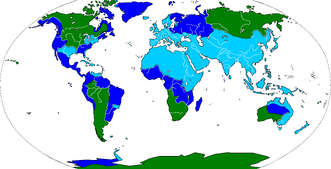
The Severan Empire is the informal name for the empire created by Roman Emperor Septimius Severus (193-211). It was a vast global empire that spanned the entire known world at the time as well as other parts of the globe, and was once thought to have been a fabrication of Severus until several archaeological discoveries verified its existence. The expansiveness of the empire and Severus' abilities to create it are still widely debated, with many holding the feat as one of the greatest human achievements of all time.
Background[]
A major factor in Severus' ability to expand the empire as he did was an unprecedented baby boom that lasted for a little over 30 years, beginning in 165. It was brought upon by the Antonine Plague (brought to Rome by Parthian traders in 160- it claimed the life of Antonius Pius a year later), which took over ten years to contain and claimed as many as five million lives across the Empire as a result. The Romans, who believed it was a sign from the gods, began to feel that their own lives were more vulnerable than they thought, spurring on the massive boom. The effects of the Plague- and the constant warfare between Marcus Aurelius and the Germans as a result of it- inspired Aurelius to pen his Meditations, which he finished in 180, the year of his death. The multitude of new children didn't affect Aurelius much, but his successor, Commodus, took stock in the new generation and tried his best to deal with the newcomers, to little success. The Emperor's strategy- when he wasn't too busy enjoying himself at the Flavian Amphitheatre- was often antagonistic, being one of the factors that led to his ultimate assassination.
The new generation, after killing Commodus, sought power of their own, spending almost the entirety of 193 fighting amongst themselves and the older generations in the Year of the Five Emperors. At the end of the year, Severus won the throne, and although he wasn't a part of the baby boom, he was the first to recognize its potential. He appointed many of the boomers to prominent positions across the Empire, and, noting the generation's fighting strength, created several new legions. It was these legions that Severus would lead on the extraordinary adventures that he would eventually become known for.
The Adventurers[]
Severus' immediate concern for his new armies was the pacification of Rome's long time enemies, the Parthians. At this time, the Parthian Empire was in decline, having been dealt a serious blow by the conquests of Trajan I, but Severus worried that it could rebound and once again be a thorn in the Roman side. After dealing with minor skirmishes from factions who still did not support him in the Imperial ranks, in 194, Severus officially led the new Legions across the frontier to take on the Parthians.
As the new Legions- whom Severus named "the Adventurers"- were still green fighting forces, the early results in Parthian territory were underwhelming, forcing Severus to regroup his forces in 198. This turned out to be a masterstroke, as the Adventurers soon scored massive victories over the Parthians, taking the capital Ctesiphon in 201 and routing what was left of Parthian resistance in 202.
In 203, amongst the ruins of the ancient city of Rhaga- near the Caspian Sea- Severus founded a new city, which he called "Colonia Severa". The city served as Severus' second capital after Rome, and thus it quickly grew in importance. The locals, though, mainly referred to it as "Severa", which in local parlance soon evolved into "Tehran", which the city retains to this day.
After establishing his base in Tehran, the Adventurers were eager to expand their territories, setting their sights on the Parthians' neighbours, the Kushans. The Kushan Emperor, Vasudeva, tried to warn off the invaders by mentioning that "Alexander the Great was felled by Indian diseases" but this was no deterrent. The Adventurers, now battle-hardened, made quick work of the Kushans, conquering the Indian subcontinent by 206.
The Adventurers' exploits soon caught the attention of Han China, who gathered a massive army to meet the threat. The Chinese strategy at first proved successful, as early Roman attempts at an invasion were repulsed. In 209, after another reorganization, the Romans again invaded, this time making quick work of the Chinese defences. The Han were not worried, believing their main army would be enough to inflict a heavy defeat on the Romans and expel them from the country. At the Battle of Luoyang, the Han seemed to have been proven right, as the Adventurers fared very poorly against seasoned Chinese warriors who knew the terrain better than they did.
Severus was forced to regroup, but even this did not prove effective. Severus then approached the Han Chancellor, Cao Cao, to offer his surrender. However, when the Han delegation approached the Roman camp, Severus stabbed Cao in the back, killing him, prompting the two armies to fight once more. This time, with the Chinese caught off guard, the Romans were victorious, with the Chinese forced to accept their rule in 210.
After the defeat of China, the Adventurers set out into the Pacific, making quick work of the nearby islands (including Japan and the East Indies) and even taking what is now the northern and eastern coasts of Australia and New Zealand. Coupled with other Legionary exploits that saw the vast majority of Europe, much of Asia, much of Africa and even parts of the Americas and Antarctica brought into Roman rule, Severus had managed to build an Empire that spanned the entire globe, becoming the first Empire "on which the Sun never set". It still remains the largest empire in world history by a wide margin, albeit- because of legendary nature Severus' tale soon entailed- one whose frontiers are still widely debated.
In 212, Severus reorganized his empire into several different "client states", each with their own Emperor and all paying tribute to Rome. His successor, Caracalla, sought to create unity across the Roman domains by bestowing Roman citizenship upon all free men across the territories, as well as advocating for a shared identity across the Empire. The reasons for this were purely practical, as Caracalla knew it would be impossible to impose direct Roman rule across such a vast amount of territory, so if the people "felt" united, Caracalla figured, they would unite the country by themselves.
Despite limited success, the expanses soon caught up to Roman officials, who were forced to abandon almost all the new territories following the Year of the Ten Emperors in 230. Some territories- such as the African territories- held out until much later, but the strains placed upon the Empire meant it had little hope to retain the possessions. With the Empire reeling, by 260 its Mediterranean heartland was now under attack, from which Rome would not recover from until reorganization in 284.
Calalus[]
The most famous of Severus' new territories- and his longest lasting acquisition- was the territory of Calalus, in what is now Arizona, Texas, the Caribbean, Cuba and the Floridian coast. It was founded in 205 by Publius Cornelius Calalus, who brought with him a fleet carrying over 5,000 people plus supplies. According to historian Ammaianus Marcellinus, Calalus' journey was intended purely as an opportunistic experience, as Calalus recruited mainly from the impoverished ranks by promising them an opportunity to "explore the world" in the hopes of finding another land where they could prosper. Calalus had no knowledge of North America as a continent or oceanic geography as a whole, and, according to Ammianus, he had to face several prospective mutinies because he overestimated how much time it would take to discover land. It was only a matter of luck that Calalus, facing another mutiny, wound up landing on the island of Eleuthera (in 197), whose name was bestowed by Calalus because it represented "freedom" from the struggles he currently faced.
Calalus wasn't satisfied with the founding of one colony, so over the next few years he sailed back to Rome and brought with him a much larger fleet with intentions of discovering more land. In 201, Calalus founded a colony near present-day Miami in Florida, falling in love with its natural beauty but finding little of value beyond the coast. So the next year, he set out again with other followers and set up the colony that would eventually bear his name, at present-day Galveston Bay. It was here where he would face his first challenges against local rulers, who forced him to several battles in 203 just to consolidate his holdings, but by 204, Calalus- using a "divide and conquer approach" similar to Julius Caesar's tactic- was able to push inland, eventually reaching the Colorado River and Arkansas River basins by 205. He officially called his territory "the Roman New World" (Terra Nova Romanum), but this didn't stick. Since many felt that he was an Emperor in his own right, his subjects named the territory after him, which he eventually warmed to once it had become too ubiquitous. He still dutifully sent Severus a tribute and pledged his loyalty, but actual authority from Rome in the area was nominal at best. Severus himself visited the territory in 207 to commemorate the achievement of his friend and give the locals a rare look at their actual Emperor, but, for the most part, Severus rarely paid much attention to Calalus.
After Severus' death, Calalus maintained his allegiance to Rome and continued providing tribute, propping up Severus' successor Caracalla when he needed it. However, Calalus' death in 225 changed the territory's politics, with Calalus' successor, Pumerus, outright refusing to continue sending the tributes to Rome. The Emperor at the time, Alexander Severus, attempted to send a ship to seek the colony's re-submission but he lacked the funds to do so, as internal struggles back home tied up his resources. Thus, in 226, Pumerus would declare the territory of Calalus an independent nation, albeit paying nominal suzerainty to Rome. Pumerus and his successors would simply name themselves "consuls" and style their government after the Republic, all while maintaining the Emperor as the head of state, even though, in effect, he had no actual power.
Calalus as a country would thus continue on for another 800 years, although by 815 outside forces would reduce the state to the capital and its environs. The capital itself would hold on until 1011, when Korvalian forces- who had come to Calalan territory from Mexico and took over much of the former colony- besieged the Calalan capital for six months, finally breaking through in November and burning the city to the ground.
The story of Calalus was known to Rome since its founding and was initially believed by Roman scholars in the centuries immediately afterward. However, as pressures mounted in Europe, the Romans had little ability to provide much attention beyond its Mediterranean frontiers, meaning the discoveries of the new worlds the Romans had made would eventually get lost, especially after the Collapse of the 5th Century. The Romans would not attempt a cross-Atlantic voyage until Christopher Columbus- one of very few in Roman territory who retained knowledge of territories beyond Eurasia- did in 1492. Calalus soon drifted into the realm of myth, where it wouldn't be uncovered until the remains of the City of Calalus was excavated in 1932 by Licinia Marvela, who subsequently discovered the rest of the colony. Since then, Calalus- and the rest of the Severan Empire, once evidence there was found- lost its doubters, although considerable debate still remains over the extent of the journeys.
